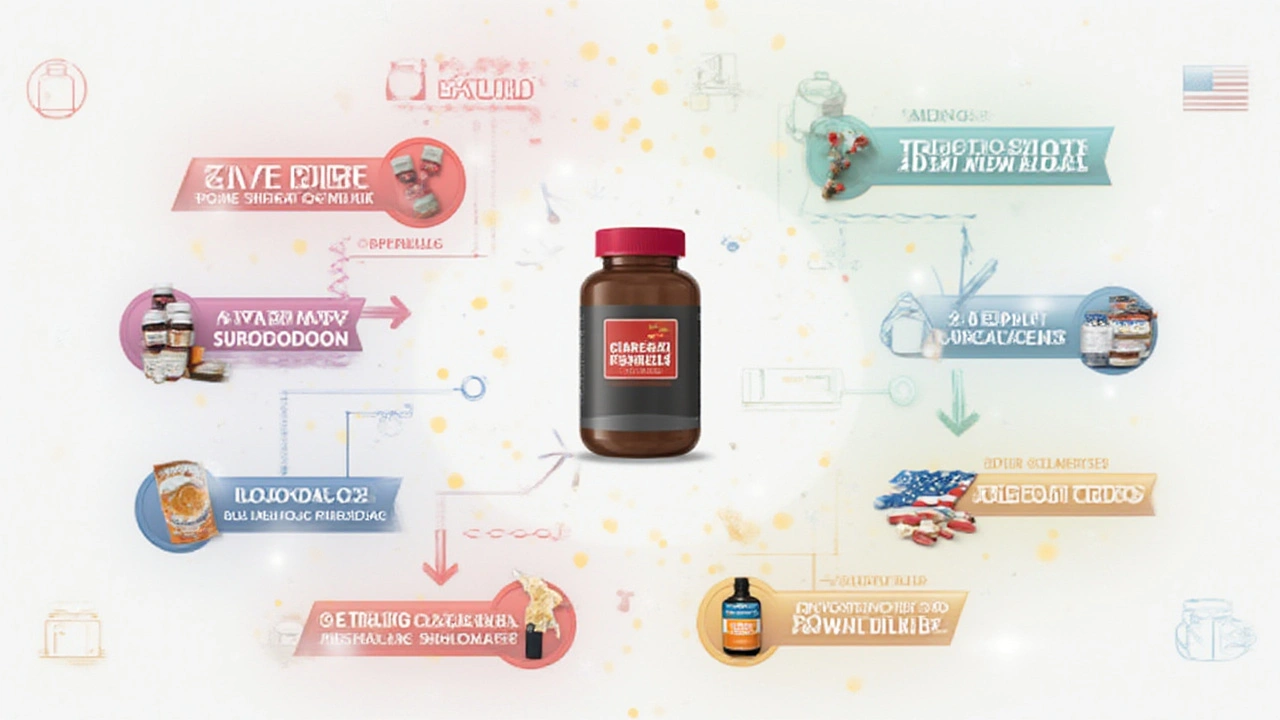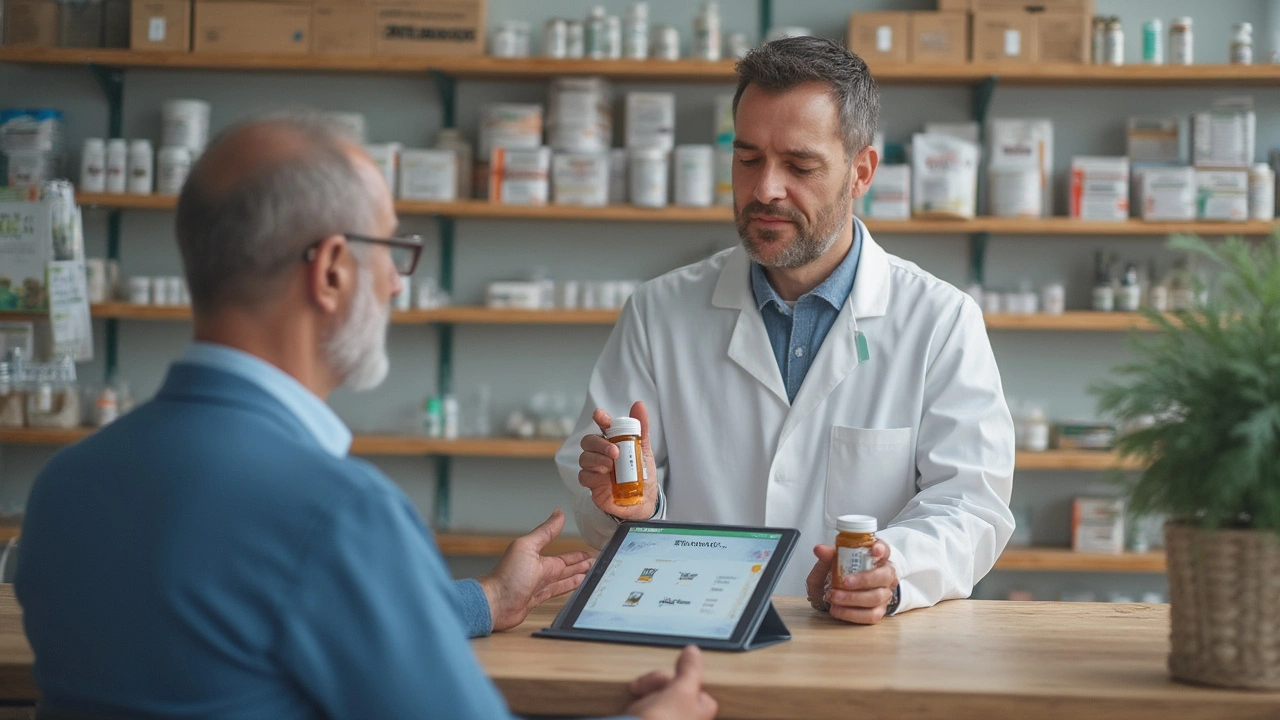Getting a prescription like etodolac might seem simple, but the real surprises often come from what else is already in your medicine cabinet. The story isn’t just whether etodolac works for your back or joint pain, but whether it might mess with your blood pressure pills, your antidepressants, or even the vitamins you toss back with breakfast. Picture this: one third of people over 60 take at least five medications daily. It only takes a single overlooked combo for trouble. And with etodolac on the list—an NSAID trusted for arthritis, gout, and random injuries—the odds for reaction go up if you don’t pay attention.
Why Etodolac Interacts: How NSAIDs Compete in Your Body
Etodolac is part of the nonsteroidal anti-inflammatory drugs family—NSAIDs for short. Think of this group as sturdy, no-nonsense pain and inflammation busters used by millions who want relief that doesn’t sedate them. These drugs slow down chemicals in your body called prostaglandins. Sounds harmless, right? Except prostaglandins help with way more than pain—like keeping your gut lining safe and making sure your blood keeps flowing through those tiny kidney arteries just right.
So why all the fuss about interactions? Because etodolac is a bit of a bully when other drugs try to do their job. If you throw it in the mix with blood thinners, some heart meds, or antidepressants, it might grab the steering wheel and drive outcomes where you don’t want them. Your body only has one set of gut, kidney, and liver enzymes to go around. When etodolac takes up more of their time, other meds can hang around too long or not work as well. Some people even make less of certain enzymes, which tosses more fuel on the fire.
The interaction web gets more tangled with age. A 2021 CDC report showed 40% of older adults had taken an NSAID that overlapped with another risky drug. Kidney problems, ulcers, and emergency room visits traced right back to these interactions. If your pharmacy has ever flagged a combo, it’s not algorithm paranoia—it’s real, studied risk.
Serious Drug Interactions: Medications You Should Double-Check
The counter at your local pharmacy is lined with risk—much of it invisible unless you know what you’re looking for. Let’s break down the main categories where etodolac can throw a wrench in the works.
- Blood thinners and anti-clotting drugs: Mixing etodolac with warfarin, apixaban, rivaroxaban, or even daily aspirin can mean trouble. Your blood might get too thin, leading to bruising or even serious bleeding, especially stomach bleeds.
- Other NSAIDs and corticosteroids: It sounds obvious, but people forget—ibuprofen, naproxen, or steroids like prednisone stack up side effects with etodolac. Double dosing NSAID- or steroid-related gut risks equals real ulcer chances.
- ACE inhibitors, ARBs, and diuretics: These are prescription mainstays for high blood pressure and heart disease—lisinopril, losartan, hydrochlorothiazide. When mixed with etodolac, the kidney takes a hit. Hospital ERs everywhere see the result: sudden drops in kidney function, sneaky sodium changes, and the odd case of swelling or heart failure spiral.
- Certain antidepressants (SSRIs, SNRIs): Etodolac can make it much easier to bleed when combined with fluoxetine, escitalopram, sertraline, venlafaxine, or similar drugs.
- Methotrexate: This one doesn’t get enough attention. Used mostly for rheumatoid arthritis or certain cancers, methotrexate can build up to dangerous levels. Etodolac slows its clearance, putting you at risk for mouth sores, low blood counts, or liver issues.
- Lithium: Anyone managing bipolar disorder with lithium needs to know: etodolac traps lithium in your body. Your doctor needs to check levels or switch pain treatments.
- Digoxin: This heart med treats atrial fibrillation and heart failure. Etodolac might increase digoxin in your blood, inviting toxicity—think nausea, confusion, and dangerous rhythms.
- Certain blood pressure drugs, including beta blockers: It’s a lesser-known fact, but chronic NSAID use can undercut the effect of beta blockers like metoprolol, carving out any benefit over time. If you’re wondering why your home blood pressure readings are creeping north, this may be the reason.
Mixing etodolac with the drugs above can sometimes help make a point: always check for interactions first, not after the fact.

Surprising Interactions Beyond Prescriptions: Supplements, Foods, and Habits
It’s not all about prescriptions. Over-the-counter supplements, random vitamins, and even certain foods get in on the act. Here’s what can sneak under the radar:
- Fish oil, turmeric, and ginkgo biloba: All three can thin your blood a little differently. Add in etodolac, and you’ve got the perfect storm for easier bleeding—even from something as simple as flossing too hard.
- Garlic or ginger supplements: Not just for cooking, these can impact clotting. Doctors sometimes pick up on unexplained bleeding and trace it back to "natural" remedies mixed with NSAIDs.
- Alcohol: Mixing etodolac and a nightly glass (or more) doesn’t just mean rough mornings. It can double your chances of stomach ulcers and guts that bleed silently. Plus, your liver works overtime when both show up together—meaning more side effects from painkillers and anything else you’re taking.
- Herbal teas and detox drinks: Certain laxative teas or detox blends can act like diuretics or change your kidney’s filtration. Add in etodolac, and those kidneys may get overwhelmed, raising blood pressure or swelling risk.
- Vitamin E: High-dose vitamin E can turn up bleeding risk, so it’s a no-go with regular etodolac.
It’s easy to forget that just because something is labeled “natural” it doesn’t mean it can’t mess with your medications. A pharmacy chain audit in 2022 caught more than 700 cases of new GI bleeding traced to unsupervised supplement use with NSAIDs like etodolac.
How to Spot and Avoid Dangerous Etodolac Interactions
Here’s where it gets practical. People don’t just wake up in the hospital with a gut bleed—they usually miss warning signs first. Pay attention to:
- Easy bruising, unexplained small purple spots, or slow-to-heal wounds
- Black, tarry, or bloody stools
- Feeling severely tired, swelling at your ankles, or sudden weight gain
- Nasty headaches, ringing in your ears, or odd confusion (especially if you’re on lithium, methotrexate, or digoxin)
- Rapid changes in blood pressure or home blood sugar readings (NSAIDs can push numbers both ways for some chronic diseases)
But the most effective shield? Take these steps seriously:
- Keep a list—on paper or on your phone—of every drug and supplement you use. Yes, including multivitamins, probiotics, herbal teas, and anything you picked up at a health food store.
- When your provider prescribes etodolac, show them that list. This single step saves time and catches most avoidable interactions.
- Don’t assume your pharmacy’s computer always catches things. Sometimes names are spelled wrong, or mail-order pharmacies don’t talk to each other.
- Never double-up on NSAIDs. If you’ve got a headache, don’t take ibuprofen just because your etodolac was for your knee. Your gut and kidneys don’t care what hurts—they just see double NSAIDs.
- Make sure any over-the-counter remedy or supplement you buy is checked with a pharmacist first.
- Don’t forget about scheduled bloodwork. Any doctor worth their salt will want labs if you’re juggling multiple interacting medications, especially if you’ve got a chronic illness or are older than 60.
- Ask about alternatives. Sometimes acetaminophen, topical pain gels, or even physical therapy does the trick without the risks.
- If you forget whether you took your dose, don’t guess and double-up "just in case." Accidental overdose drives most ER visits for NSAIDs in older adults.
If something feels off, call your doctor, not Google. Worrying about bothering your nurse is nothing compared to ignoring real symptoms.

Fact Sheet: Common Etodolac Interactions at a Glance
If you want a quick cheat sheet, here’s a table that lists the most serious and most common interactions with etodolac. Use this for your next appointment or pharmacy visit:
| Medication/Supplement | Interaction Risk | What Can Happen |
|---|---|---|
| Warfarin, Apixaban, Rivaroxaban | High | Increased bleeding, GI bleed |
| Lisinopril, Losartan (ACE/ARB) | High | Kidney injury, higher blood pressure |
| Thiazide Diuretics | Medium | Low sodium, kidney effects |
| Methotrexate | High | Methotrexate toxicity, mouth sores |
| SSRIs/SNRIs | Medium | Increased risk for bleeding |
| Lithium | High | Lithium toxicity signs |
| Alcohol | Medium | GI ulcers, liver stress |
| Fish oil, Vitamin E | Low to Medium | Mildly increased bleeding risk |
With etodolac, the bottom line is being honest about every other thing you’re swallowing—medications, vitamins, supplements, energy drinks, you name it. If Megara ever starts a new supplement, I’ve learned to double-check. Once she almost combined turmeric capsules and etodolac while treating her own ankle sprain. It’s not paranoia—it’s smart.
Etodolac helps millions live with less pain, but it doesn’t play nicely with everything. Take drug interactions seriously, trust your gut if you notice new or weird symptoms, and remember: your pharmacist and doctor aren’t just there for the prescription—they’re your drug interaction shield.
